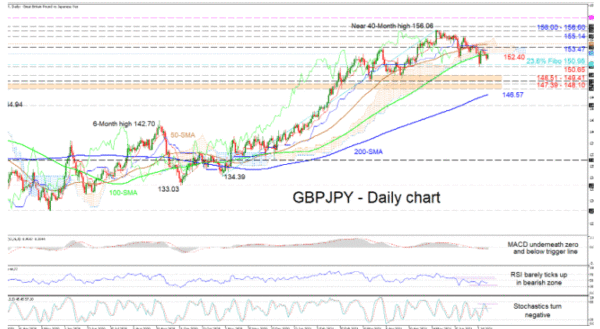GBPJPY has been deteriorating for around a month-and-a-half now, logging lower highs and lows from its near 40-month peak of 156.06. The bullish charge in the 50- and 100-day simple moving averages (SMAs) is becoming slightly sluggish, with their slopes suggesting positive drive has abated somewhat. Even though the Ichimoku lines are demonstrating a pause in negative momentum, they are retaining a slight bearish preference.
The short-term oscillators are transmitting conflicting signals in directional momentum. The MACD, not too far under the zero level, is below its red trigger line, while the RSI is marginally improving in bearish territory. In spite of buyers pushing back, the negative bearing of the stochastic oscillator is implying negative price action may resume sooner rather than later.
To the upside, buyers face an immediate zone of resistance from the red-Tenkan-sen line merged with the 100-day SMA at 152.40 until the 153.47 nearby high. Conquering this obstacle and overstepping the cloud, the 50-day SMA at 154.00 could impede the price from jumping to test the June 23 high of 155.14. Should buyers’ confidence grow, they could then try to pilot past the resistance ceiling shaped between the 156.00 hurdle and the February 2018 rally peak of 156.60, an area that also contains the 156.06 multi-year high of a near seven-month uptrend.
If sellers resume control, initial support could come from the 150.96 and the 150.65 barriers respectively, the former being the 23.6% Fibonacci retracement of the up leg from 134.39 until 156.06. However, a sharp dive below these upside defences could drive the pair towards the vital support base of 148.51-149.41. Should a deeper price retraction mature below this limiting region, the critical border of 147.39-148.10, which also contains the December 2019 high of 147.95, may then be challenged.
In conclusion, GBPJPY is demonstrating a bearish demeanour in the near-term and a break below the 150.65 trough could boost negative price action. Yet, a shift above the cloud is needed to realign the pair with the broader bullish picture.













